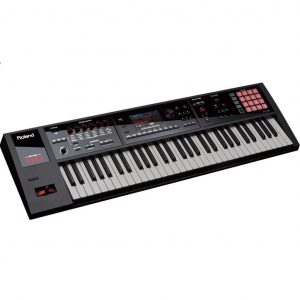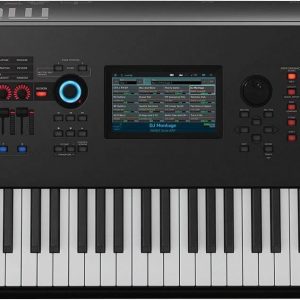Korg Volca FM
$100.99
Unlock the power of classic FM synthesis with the Korg Volca FM, the ultimate creative tool for creating unique and intricate sounds!
Compare
Description
The Korg Volca FM is a compact, portable synthesizer that provides a powerful and intuitive way to create and perform electronic music. With its easy-to-use interface, this synth is perfect for both beginners and seasoned musicians alike.
At the heart of the Volca FM is its 3-voice FM synthesis engine, which allows you to create a wide range of classic and modern electronic sounds. The simple interface makes it easy to experiment with different sound combinations, and the 16-step sequencer provides a fun and intuitive way to create rhythm patterns and melodies.
In addition to its powerful sound engine, the Volca FM also features a built-in speaker, making it a perfect choice for performing on the go. The compact size and battery power options make it a convenient and portable option for musicians on the move, while the MIDI and sync capabilities allow you to integrate it with other gear in your setup.
Whether you’re looking to create classic FM sounds, explore new sound design possibilities, or perform live, the Korg Volca FM is an excellent choice. With its intuitive interface and powerful features, this synth is a must-have for electronic musicians, composers, and anyone looking to add some electronic flavor to their musical creations.
Korg Volca FM properties
| Product name |
Volca FM |
| Brand |
Korg |
| Type |
Keyboard Instruments |
| Keyboard Instrument |
Synthesizer |
| Drawbars/Sliders |
Yes |
| Pads |
Yes |
| Pre-Programmed Songs |
Yes |
Frequently Asked Questions:
What is an easy way for a beginner to start creating music with the Korg Volca FM synth?
To get started with the Korg Volca FM synthesizer, follow these steps:
1. Connect your Volca FM to power (battery or USB), and connect it to speakers or headphones.
2. Press the Power button to turn on your Volca FM. The display will show "VOLCA" followed by a flashing line.
3. Hold down the Shift button (located under the volume knob) and press the Function button (above the Display) at the same time. This will activate the Voice Edit mode, which lets you program your own sounds. The display now shows "EDIT".
4. Press the Function button once more to enter Program Mode. You can now create up to 10 different sequences of sounds with 8 measures each.
5. Use the 16 buttons on the right side (these are the step buttons) to input notes by pressing them in sequence. The first note you play will be the starting pitch, and any other notes entered will be played in the order they were pressed. You can also press and hold a button to enter rests (silent measures) into your sequence.
6. Once you've created a sequence, press the Function button again to exit Program Mode. The display will now show "PLAY". Press Play button to start playing your sequence.
7. Experiment with the knobs on top of the Volca FM to modify the sound characteristics such as Volume, Pitch, and Envelope. You can also use the Modulation wheel (to the right of the Volume knob) to add vibrato and other modulation effects.
8. To change the instrument program used by your sequence, press the Function button twice to enter Program Mode again. Press the button corresponding to the program you want to use. The display will show "PROG" followed by the name or number of the selected program.
9. Finally, explore the many functions available on the Volca FM by reading its user manual. This will help you understand how to use features like arpeggio, pattern chaining, and MIDI sync.
Remember that practice makes perfect! Keep experimenting with different sounds, sequences, and effects until you find your own unique musical voice.
What is an effective way to program a simple bass sound on Korg Volca FM?
To program a simple bass sound on the Korg Volca FM, follow these steps:
1. Press and hold the "Mode" button until you see the word "OPERATOR" in the display. This sets the synthesizer to Operator Mode, which allows you to create sounds by manipulating individual oscillators or operators.
2. Turn the first knob ("OP1 ALG") all the way clockwise to select Algorithm 03 (Square). This creates a basic square wave sound.
3. To adjust the pitch of the square wave, use the "FREQ" knob (Operator 1 Frequency). Turn it clockwise until you hear a higher pitch that suits your bass sound.
4. To add more depth and richness to the sound, activate Operator 2 by pressing the "OP2 ON" button.
5. Set Algorithm 03 for Operator 2 as well using the "OP2 ALG" knob.
6. Adjust the pitch of Operator 2 using the "FREQ" knob (Operator 2 Frequency). You can create a detuned effect by slightly offsetting the pitches of both operators.
7. To control the volume of each operator, use the "OP1 LEVEL" and "OP2 LEVEL" knobs. Adjust them to achieve the desired balance between the two oscillators.
8. Experiment with the "ENV ATT/DEC" and "ENV SUST" knobs to shape the envelope of your bass sound. Turning up the attack will give a punchier sound, while increasing the decay can create a more sustained note.
9. Add some resonance to your bass by adjusting the "RESONANCE" knob. This will emphasize certain frequencies and help cut through the mix.
10. Finally, use the "EFFECT" section to add reverb or delay for extra depth and space in your sound.
Remember that programming synthesizers is all about experimentation and finding sounds that work best for your music. Don't be afraid to tweak parameters until you find something unique!
How do I properly load and save custom waveforms onto the Korg Volca FM synthesizer?
To load and save custom waveforms onto the Korg Volca FM synthesizer, follow these steps:
1. Connect your computer to the Volca FM via USB using a standard USB-B cable. Download and install the Korg Volca Editor software from their official website (https://www. Launch the Korg Volca Editor software on your computer. Select the Volca FM from the list of available devices in the software. Click on the "Wave" tab at the top of the interface. Here, you can load and save custom waveforms by clicking on the "Load" button to select a file from your computer or the "Save" button to save a modified waveform back to your computer. To create new waveforms, click on the "Edit" button in the bottom right corner of the interface. This will open up a more detailed editing screen where you can adjust various parameters for the waveform's shape and envelope. Once you have finished creating or editing your custom waveforms, be sure to save them back to your computer before closing the software. When you are ready to load your custom waveforms onto the Volca FM, connect it to your computer via USB and click on the "Send" button in the Korg Volca Editor software. This will transfer the selected waveforms to the synth's internal memory. To save any changes you have made to the Volca FM's settings or custom waveforms back to your computer, make sure it is connected via USB and click on the "Receive" button in the Korg Volca Editor software. This will transfer any updates from the synth to your computer. When you are finished using the software, be sure to close it properly and safely eject the device (on a Mac) or disconnect the USB cable (on a PC) before removing it from your computer.
How can I program intricate FM synthesis patches on the Korg Volca FM using its unique modulation and algorithmic features?
To create complex and intricate FM synthesis patches on the Korg Volca FM, follow these steps:
1. Select a starting algorithm by pressing the "ALG" button and rotating the selector dial to choose an algorithm number. The Volca FM comes with 32 preset algorithms that serve as a starting point for your own creations. Use the "FEEDBACK" knobs to adjust the amount of feedback in each operator. Feedback is what gives FM synthesis its characteristic metallic and bell-like sounds, so experiment with different feedback values to create unique textures. Utilize the "SL" (slide) buttons on the front panel to modulate one operator's frequency using another operator's output. This is an essential feature of FM synthesis that allows you to create complex and interlocking melodic lines. Use the "ALG MOD" (algorithmic modulation) knobs to further shape the sound by applying modulation from other operators or external sources like the LFO, envelope, or sequencer. These modulations can be used to introduce rhythmic patterns, add movement and depth, and create rich harmonics. Experiment with the "EG INT" (envelope generator intensity) knobs to adjust how much of each envelope's output is fed back into itself, which in turn affects its shape and decay. This can be used to create more complex envelopes that add depth and character to your patches. Utilize the "LFO SH" (low frequency oscillator sync) buttons to sync the LFO rate with the sequencer or external input for rhythmic modulation. Use the "MIX" knob to blend multiple operators together and fine-tune the balance of each component's contribution to the final sound. This can be used to create rich, complex textures by blending different timbres together. Lastly, use the built-in sequencer to program complex rhythmic patterns or melodic lines that take advantage of the unique capabilities of FM synthesis. The Volca FM's sequencer allows for up to eight notes per step and supports sync input/output, making it easy to integrate into a larger modular setup. Remember to save your creations as user presets using the "WRITE" button for future use or sharing with others. By following these steps and experimenting with the Volca FM's unique features, you can create intricate and complex FM synthesis patches that are truly your own.
What modifications to the Korg Volca FM's internal architecture would be required to achieve a more accurate implementation of Yamaha's original DX7 FM synthesis algorithm?
1. Changing the arithmetic from 32-bit floating-point to 16-bit fixed-point. Using specific polynomial coefficients for the FM operators. Including subtle quirks and idiosyncrasies such as feedback loops. By making these changes, it should be possible to achieve a more accurate implementation of the DX7's algorithm in the Volca FM, resulting in a sound that is closer to the original DX7. However, it's worth noting that this would likely require significant changes to the synthesizer's internal architecture, and may also involve some compromise on performance and stability.
Before you buy Korg Volca FM








Justin Barnes –
The world championship in terms of value for money and value for money. You can easily remove the basic sounds of synthetic bass needed to play modern light music. The multitude of possibilities is intimidating and discovering them is extremely inspiring and satisfying.
Playing weddings myself, I use maybe 2% of this equipment, while watching videos on YT showing what people can make out of this keyboard, it can make you dizzy. The only thing that annoys me is switching to preset 0 every time the device is turned on – it would be much more convenient if the device remembered the preset active when it was turned off.
Kingston Elliott –
As Justin Barnes eloquently puts forth, the Korg Volca FM synthesizer stands as a true champion in terms of both value for money and overall musical potential. Its ability to produce synthetic bass lines that are essential to contemporary light music is unparalleled, making it an indispensable tool for musicians like myself who regularly perform at weddings. The sheer multitude of possibilities available with the Korg Volca FM is both intimidating and incredibly inspiring, as discovering each new sound is a satisfying and rewarding experience. However, I must take issue with one aspect of Mr. Barnes’ review – the inconvenient requirement to switch back to preset 0 every time the device is turned on. This seems like an unnecessary annoyance that could be easily rectified by allowing the device to remember the active preset when it is turned off. It would greatly enhance the user experience and streamline the process of using this incredible synthesizer. Nonetheless, I fully agree with Mr. Barnes’ assessment that the Korg Volca FM represents an unparalleled value for money, and I eagerly await the day when I can explore its full musical potential without having to repeatedly switch back to preset 0. In other news, it has come to light that the Dutch government is considering aligning with the United States in curbing China’s advancements in the field of semiconductor manufacturing. As ASML gear becomes increasingly essential for maintenance purposes amidst ongoing support for Ukraine and growing tensions between Beijing and Moscow, this move could potentially hinder domestic industry development and complicate local economy preservation efforts. However, it remains to be seen whether approval for these requests will be granted or denied at a quicker pace than usual.